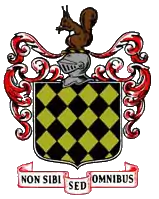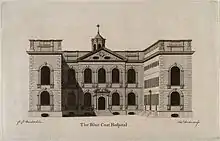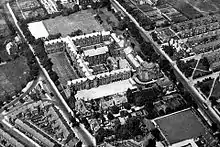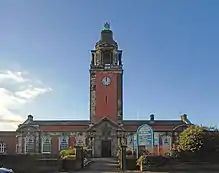Liverpool Blue Coat School
The Liverpool Blue Coat School is a grammar school in Wavertree, Liverpool, England. It was founded in 1708 by Bryan Blundell and the Reverend Robert Styth as the Liverpool Blue Coat Hospital and was for many years a boys' boarding school before reverting in September 2002 to its original coeducational remit.
| Liverpool Blue Coat School | |
|---|---|
 | |
| Address | |

| |
Church Road , , L15 9EE | |
| Coordinates | 53.393°N 2.916°W |
| Information | |
| Type | Grammar school Academy |
| Motto | Non Sibi Sed Omnibus (Not for Oneself but for All) |
| Established | 1708 |
| Founders | Bryan Blundell and Rev. Robert Styth |
| Department for Education URN | 137916 Tables |
| Ofsted | Reports |
| Headmaster | Scilla Yates (Temporary) |
| Chaplain | Interregnum |
| Gender | Coeducational (since 2002) |
| Age | 11 to 18 |
| Enrollment | 1107[1] |
| Houses | Bingham Blundell Graham Shirley Styth Tod[2] |
| Former pupils | Old Blues[3] |
| Website | bluecoatschoolliverpool.org.uk |
The school holds a long-standing academic tradition. Examination results consistently place it top of the national GCSE and A-level tables. In 2016 Blue Coat was ranked as the best school in the country based on GCSE results.[4] In 2015 it was The Sunday Times State School of the Year.[5] The acceptance rate for admissions is around fifteen percent.
In 2004 the school received a government grant of almost £8 million, together with £1 million from its foundation governors, enabling an expansion and redevelopment of its site.[6]
History
The Bluecoat School

The school was founded in 1708 by Bryan Blundell and the Rev Robert Styth, a theology graduate of Brasenose College, Oxford[7] as "a school for teaching poor children to read, write and cast accounts".[8] The original charity school expanded rapidly and a new building, the present Bluecoat Arts Centre, opened in 1718. By the time of Blundell's death in 1756 there were 70 boys and 30 girls at the school, many apprenticed to local trades, especially maritime ones connected to the port. Some Old Blues became mates or masters of their ships, many emigrating to the colonies. After Blundell's death his sons further expanded the building to accommodate 200 pupils, with a new workroom, sick room, chapel and refectory. A reminder of the building's school days is some graffiti dating from the 18th century, carved into cornerstones in a secluded part of the front courtyard.[9]
Move to Wavertree


At the start of the 20th century it was decided that the school needed to move from the polluted town centre to somewhere quieter, and the village of Wavertree was the site chosen.[8] The architects chosen for the design of the new building were Briggs, Wolstenholme & Thornely,[10] most notable for the design of the Port of Liverpool Building.[11] In 1906 the school took possession of the building,[8] which was later designated Grade II-listed*.[12] Later additions include a clock tower and the Fenwick Memorial Chapel: used for assemblies by the school.[8]
Redevelopment
In 2004 work began on redeveloping the Wavertree site. Original buildings remained intact but the southern wing was converted into private accommodation and sold to part-fund the development. The school chapel, clock tower, board room, and former music room, together with administrative rooms and the formal entrance to the original building, were transferred to a new school foundation and made available to hire for private functions. Buildings that had been added to the north end of the site during the second half of the 20th century, including a swimming pool, a sixth-form centre, a gym and squash courts, were demolished to make way for new facilities. The North Wing of the original school was renovated and a new building extended it into the area previously known as the North Yard. This included laboratories, a new main entrance, an administration block, music rooms, recording and dance studios, and dining and sports halls. The remainder of the North Yard was upgraded to provide better outdoor sports facilities. The old dining hall, beneath Shirley Hall at the heart of the original building, became a library with a mezzanine ICT suite. The previous library space, itself a former dormitory, was refurbished as the new sixth-form facility.
Brotherly Society
The school's alumni association is the Brotherly Society, founded in 1838. Alumni are known as "Old Blues".[13] The society was set up to provide help, advice and in some cases financial assistance to students for at least two years after leaving the school.[14] Since the Second World War there has been less need for such assistance so the Society has turned its efforts towards objects that would benefit the School in general.
The generosity of the Society can be found throughout the Blue Coat School's history. In 1938, to celebrate the Society's centenary, the Society provided the oak pews in the chapel. In 1963 the Society provided the stained glass south window of the Chapel to celebrate its 125th anniversary, and in 1952 the Old Blues' Memorial Library was presented in remembrance of the Old Blues who gave their lives in the two World Wars.[14]
Headmasters
| Headmaster/Headmistress | Start year | End year |
|---|---|---|
| Rev Robert Styth, MA (Oxon) | 1708 | 1713 |
| Mr William Trenton | 1717 | 1723 |
| Mr Theophilus Price | 1723 | 1725 |
| Mr Horton | 1725 | 1775 |
| Rev John Shakleton | 1776 | 1779 |
| Mr John Smith (Old Blue) | 1779 | 1799 |
| Mr Robert Parkes | 1800 | 1800 |
| Mr George Chambers | 1801 | 1811 |
| Mr John Fallows | 1812 | 1816 |
| Mr R.W. Bamford | 1817 | 1819 |
| Mr William Forster | 1820 | 1848 |
| Mr Thomas Wood, BA (Cantab) | 1849 | 1862 |
| Mr Thomas Haughton | 1863 | 1867 |
| Mr George Tinker | 1868 | 1869 |
| Mr Thomas Haughton | 1870 | 1888 |
| Mr Arthur Mercer | 1889 | 1920 |
| Mr Harry C. Hughes | 1920 | 1926 |
| Rev R. Bruce Wilson, BA (Oxon) | 1927 | 1944 |
| Rev T.C. Heritage, MA (Oxon) | 1944 | 1945 |
| Mr G.G. Watcyn, BA | 1945 | 1968 |
| Mr H.P. Arnold-Craft JP, MA (Oxon) | 1968 | 1989 |
| Mr John C. Speller BA, MA (Ed), FRSA | 1989 | 1997 |
| Mr Michael R. Bell BA (Hons) FIMgt | 1997 | 2001 |
| Mr Michael George 'Sandy' Tittershill CertEd. NPQH | 2001 | 2008 |
| Mrs Debbie Silcock BSc PGCE NPQH | 2008 | 2015 |
| Mr Michael Pennington BSc Hons PGCE NPQH | 2015 | 2019 |
| Mrs S Yates | 2019- |
The Squirrel
The school's publication is The Squirrel. The magazine is currently published annually and is almost entirely written and produced by students. The magazine was first released in the Summer of 1949 under the leadership of the Provost John Bingham in order to show the 'fruits of hard work' and the activities, achievements, and involvement of the students and staff in school life.[16]
During the 1950s The Squirrel entered an era of particular popularity and enthusiasm, ultimately leading to its publication becoming a termly occurrence. It was during this period that the magazine developed some of its most memorable features, notably including De Praefectis which recorded the various humorous situations and conversations of prefects at the school and is mostly remembered for satirising the eccentricities of individual prefects, often employing a pretentious overuse of Latin to this effect. In subsequent years various other magazines written by students were produced as parodies of The Squirrel, most notably in the form of The Swivel which gained an underground following and was particularly popular on account of the strong criticisms it leveled at the school and its masters.[16]
In 2017 the school published The Squirrel both in paper form and online for the first time. A new website 'The Squirrel Blog' was created both to publish current and future editions of the magazine and to digitalise the school's archive of every issue of The Squirrel since 1949.
References
- "The Blue Coat School". GOV.UK. Retrieved 4 January 2021.
- "Tod House celebrations". The Liverpool Blue Coat School. Retrieved 20 December 2020.
Named in recognition of the longstanding contribution of the Tod family, Tod House will sit alongside Blundell, Bingham, Graham, Shirley and Styth, from September.
- "About us". The Liverpool Blue Coat Old Blues' Association. Retrieved 20 December 2020.
What is an "Old Blue"? Quite simply, this is any person who, in the past, has been a student or teacher at the Liverpool Blue Coat School.
- https://www.telegraph.co.uk/education/leaguetables/12109955/Top-100-secondary-schools-by-GCSE-results-2015.html
- http://www.thesundaytimes.co.uk/sto/Parent_Power/
- Salmon, Tony (2007). "Save the Liverpool Blue Coat School". savethebluecoat.webeden.co.uk. Retrieved 24 June 2009.
- "Stermont-Synge". British History Online. Retrieved 28 November 2015.
- "A brief history of the school". The Liverpool Blue Coat School. Archived from the original on 7 July 2013. Retrieved 6 January 2010.
- "Bluecoat Heritage" (PDF). Bluecoat Chambers. Archived from the original (PDF) on 4 January 2014. Retrieved 24 May 2015.
- Richard Pollard; Nikolaus Pevsner; Joseph Sharples (2006). Lancashire: Liverpool and the southwest.
- "The Port of Liverpool Building". liverpoolworldheritage.com. Archived from the original on 29 April 2009. Retrieved 29 June 2009.
- "The Liverpool Blue Coat School General information". Schools Net. Retrieved 29 June 2009.
- Kelly, Andy (19 January 2006). "Million-Pound Target for Historic Blue Coat". Liverpool Daily Post. Liverpool. Archived from the original on 7 October 2018. Retrieved 30 January 2016 – via HighBeam Research.
- "Brotherly Society". The Blue Coat School. Retrieved 28 November 2015.
- "Our History". The Liverpool Blue Coat School. Retrieved 4 January 2021.
- "The History of the Squirrel: The Squirrel Blog". squirrel.bluecoatschoolliverpool.org.uk. Retrieved 25 October 2017.
External links
- Official school website
- BBC Education League Tables listing
- Ofsted inspection report (June 2004)
- Extract from Discovering Historic Wavertree
- Blue Coat Arts Centre
- South Wing Apartments Development
- Leavers Ball 2006 Pictures
- Historic England. "School (1280374)". National Heritage List for England.
- Historic England. "Chapel (1068325)". National Heritage List for England.